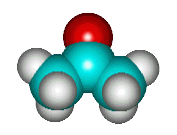 |
|
|
acetone |
HMPA - Hexamethylphosphoramide |
(CH3)2C=O |
((CH3)2N)3P=O |
Polar Aprotic Solvents
These solvents are polar enough to dissolve many salts (i.e, anionic nucleophiles) yet do not form strong attractions ("hydrogen bonds") to anions. Therefore, the nucleophile is left free to react, thus facilitating SN2 reactions. With HMPA the attraction to anions is even weaker because the partial positive charge is mostly on phosphorus and this atom is buried in beneath all of the methyl groups so that anion can't get close enough to be attracted to it.
Click on the images to go to interactive models of these compounds.